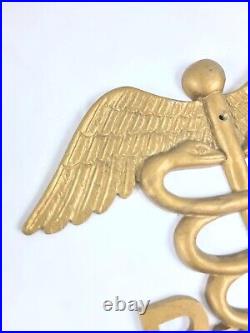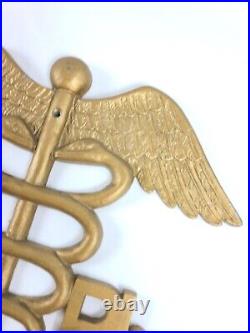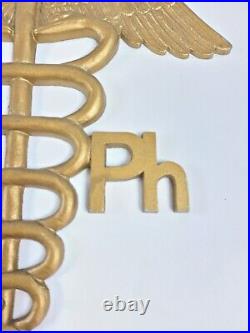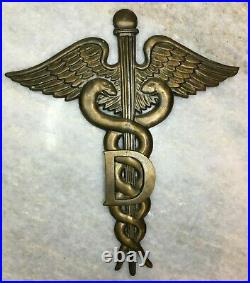
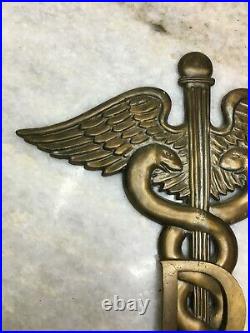
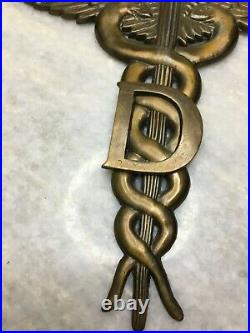
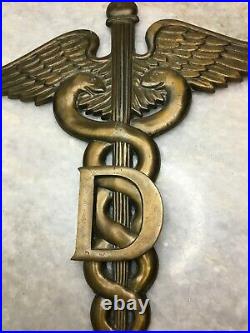
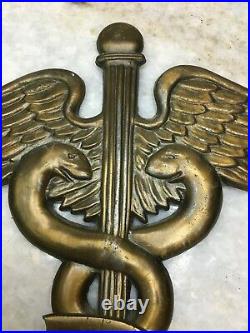
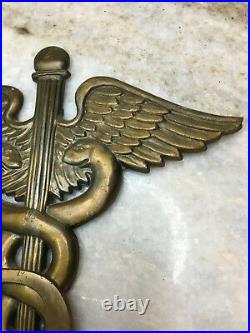

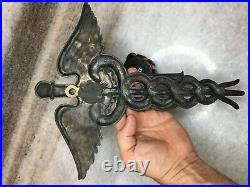

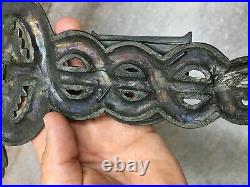


Brass Colored (I believe the base metal is some steel-alloy). Has the classic Cadueus design with a large letter “D” overlaid on the piece for Doctor. 10.25″ W wing to wing; 12″ T. Please note that one wing-tip has a very small edge missing as pointed out in the pics. Rare/ Hard to find item. From Wikipedia, the free encyclopedia. This article is about the Greek symbol. For the (mis)usage as a medical symbol, see Caduceus as a symbol of medicine. For the medical symbol with one snake, often mistakenly referred to as a caduceus, see Rod of Asclepius. For other uses, see Caduceus (disambiguation). Modern depiction of the caduceus as the symbol of logistics. Carrying a winged caduceus upright in his left hand. A Roman copy after a Greek original of the 5th century BCE Museo Pio-Clementino. Keru´keion “herald’s wand, or staff”. Is the staff carried by Hermes. And consequently by Hermes Trismegistus. The same staff was also borne by heralds in general, for example by Iris. The messenger of Hera. It is a short staff entwined by two serpents. Sometimes surmounted by wings. In Roman iconography, it was often depicted being carried in the left hand of Mercury. The messenger of the gods. Some accounts suggest that the oldest known imagery of the caduceus has its roots in a Mesopotamian origin with the Sumerian god Ningishzida. Whose symbol, a staff with two snakes intertwined around it, dates back to 4000? As a symbolic object, it represents Hermes (or the Roman Mercury), and by extension trades, occupations, or undertakings associated with the god. The caduceus provided the basis for the astrological symbol. Representing the planet Mercury. Thus, through its use in astrology. It has come to denote the planet. Of the same name. It is said the wand would wake the sleeping and send the awake to sleep. This association is ancient, and consistent from the Classical period to modern times. The caduceus is also used as a symbol representing printing, again by extension of the attributes of Mercury (in this case associated with writing and eloquence). The caduceus is often incorrectly used as a symbol of healthcare organizations and medical practice. Particularly in the United States of America. Due to confusion with the traditional medical symbol, the Rod of Asclepius. Which has only one snake and is never depicted with wings the logo of the World Health Organization. Uses the Rod of Asclepius as its basis. Origin and comparative mythology. Confusion with Rod of Asclepius. Further information: Serpent worship. Hermes hastens bearing his kerukeion, on an Attic. 475 BC, attributed to the Tithonos Painter. The term kerukeion denoted any herald’s staff, not necessarily associated with Hermes in particular. In his study of the cult of Hermes, Lewis Richard Farnell. (1909) assumed that the two snakes had simply developed out of ornaments of the shepherd’s crook used by heralds as their staff. This view has been rejected by later authors pointing to parallel iconography in the Ancient Near East. It has been argued that the staff or wand entwined by two snakes was itself representing a god in the pre-anthropomorphic era. It would thus be a predecessor of the anthropomorphic Hermes of the classical era. The Caduceus, symbol of God Ningishzida. On the libation vase of Sumerian. Caduceus symbol on a punch-marked coin. Third to second century BC. (1910) discovered that symbols similar to the classical caduceus sometimes appeared on Mesopotamian cylinder seals. He suggested the symbol originated some time between 3000 and 4000 BC, and that it might have been the source of the Greek caduceus. Ward’s research into his own work, published in 1916, in which he suggested that the prototype of Hermes was an “Oriental deity of Babylonian extraction” represented in his earliest form as a snake god. From this perspective, the caduceus was originally representative of Hermes himself, in his early form as the Underworld god Ningishzida. “Messenger” of the “Earth Mother”. The caduceus is mentioned in passing by Walter Burkert. As “really the image of copulating snakes taken over from Ancient Near Eastern tradition”. In Egyptian iconography, the Djed. Pillar is depicted as containing a snake in a frieze of the Dendera Temple complex. In the biblical Books of Kings. 2 Kings 18:4. Is a derogatory name given to a bronze serpent on a pole first described in the Book of Numbers. Which God told Moses to erect so that the Israelites. Who saw it would be protected from dying from the bites of the “fiery serpents”, which God had sent to punish them for speaking against Him and Moses. The caduceus also appears as a symbol of the punch-marked coins. Of the Maurya Empire. In India, in the third or second century BC. Numismatic research suggest that this symbol was the symbol of the Buddhist king Ashoka. This symbol was not used on the pre-Mauryan punch-marked coins, but only on coins of the Maurya period, together with the three arched-hill symbol. The “peacock on the hill”, the triskelis. It also appears carved in basalt rock in few temples of western ghats. The Caduceus in classical imagery. In the center is Mercury. Holding the caduceus and on the right Juno. Sits on her throne. On the left is Vulcan. Figure standing behind the wheel, with Ixion already tied to it. Sits at Mercury’s feet; a Roman fresco from the eastern wall of the triclinium. In the House of the Vettii. Iris with the caduceus in detail from an Attic red-figure. Middle of fifth century BC Agrigento. (Turkey) with caduceus c. To Hermes relates how his half brother Apollo. Got enchanted by Hermes music from his lyre fashioned from a tortoise shell, Hermes kindly gift it to him. Apollo in return gave Hermes the caduceus as a gesture of friendship. The association with the serpent thus connects Hermes to Apollo. As later the serpent was associated with Asclepius. The “son of Apollo”. The association of Apollo with the serpent is a continuation of the older Indo-European. (1913) pointed out that the serpent as an attribute of both Hermes and Asclepius is a variant of the pre-historic semi-chthonic serpent hero known at Delphi as Python. , who in classical mythology is slain by Apollo. One Greek myth of origin. Of the caduceus is part of the story of Tiresias. Who found two snakes copulating and killed the female with his staff. Tiresias was immediately turned into a woman, and so remained until he was able to repeat the act with the male snake seven years later. This staff later came into the possession of the god Hermes, along with its transformative powers. Another myth suggests that Hermes (or Mercury) saw two serpents entwined in mortal combat. Separating them with his wand he brought about peace between them, and as a result the wand with two serpents came to be seen as a sign of peace. Refers to the caduceator who negotiated peace arrangements under the diplomatic protection of the caduceus he carried. In some vase paintings ancient depictions of the Greek kerukeion are somewhat different from the commonly seen modern representation. These representations feature the two snakes atop the staff (or rod), crossed to create a circle with the heads of the snakes resembling horns. This old graphic form, with an additional crossbar to the staff, seems to have provided the basis for the graphical sign of Mercury. Used in Greek astrology. During the early modern period. The caduceus was used a symbol of rhetoric. (associated with Mercury’s eloquence). Allegory of Rhetoric (1650). ALCHEMICAL SYMBOL FOR CADUCEUS. Caduceus is encoded in Unicode. Is encoded at U+1F750. In both cases, the actual glyph. Displayed (or not) is font dependent. The symbol is also depicted on multiple coats of arms. Caduceus in modern use. Caduceus on the coat of arms of Jyväskylä. Coat of arms of Tampere. Coat of arms of Lassay-les-Châteaux. Coat of arms of Saint-Pantaléon. Coat of arms of Gmina Nur. Coat of arms of Irbit. Coat of arms of Bengtsfors Municipality. Coat of arms of Balta. Coat of arms of Berdychiv. Coat of arms of Kharkiv. With a Caduceus crossed with a golden key at the center. With a Caduceus crossed with a golden key at the lower fly half. Flag of the City of Brisbane. Flag of Vancouver Island. This item is in the category “Home & Garden\Home Décor\Plaques & Signs”. The seller is “cosmic_goods” and is located in this country: US. This item can be shipped to United States.
- Style: Antique
- Material: steel, Brass
- Type: Plaque
- Brand: Unbranded




